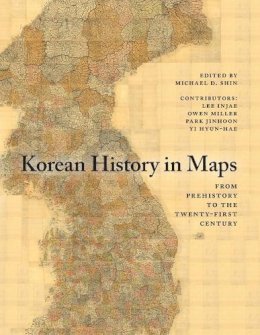8%OFF

Stock image for illustration purposes only - book cover, edition or condition may vary.
Korean History in Maps: From Prehistory to the Twenty-First Century
Lee Injae
€ 31.99
€ 29.38
FREE Delivery in Ireland
Description for Korean History in Maps: From Prehistory to the Twenty-First Century
Paperback. A concise, beautifully illustrated historical atlas of Korean history, specifically designed for English-speaking students of Korean and East Asian history. Editor(s): Shin, Michael D. Num Pages: 200 pages, 28 b/w illus. 100 colour illus. 27 tables. BIC Classification: 1FPK; HBJF. Category: (P) Professional & Vocational; (U) Tertiary Education (US: College). Dimension: 274 x 219 x 14. Weight in Grams: 754.
Korean History in Maps is a beautifully presented, full-color atlas covering all periods of Korean history from prehistoric times to the present day. It is the first atlas of its kind to be specifically designed for students in English-speaking countries. There is a map for each era in Korean history, showing every major kingdom or polity that existed on the Korean peninsula, and maps are also included for topics of additional historical interest, including each major war that took place. In addition, the atlas contains chronologies, lists of monarchs, and overviews of the politics, economy, society, and culture for each era which are complemented by numerous photos and full color images of artifacts, paintings, and architectural structures. This fascinating historical atlas is a complete reference work and unique teaching tool for all scholars and students of Korean and East Asian history.
Product Details
Publisher
Cambridge University Press
Format
Paperback
Publication date
2014
Condition
New
Number of Pages
200
Place of Publication
Cambridge, United Kingdom
ISBN
9781107490239
SKU
V9781107490239
Shipping Time
Usually ships in 4 to 8 working days
Ref
99-3
About Lee Injae
Michael D. Shin is a lecturer in Korean Studies at the University of Cambridge. His research focuses on the Japanese colonial period (1910–45), and he has published many articles on the intellectual, literary, and social history of the early twentieth century. Lee Injae is a professor in the Department of History and Culture and Dean in the College of Humanities and Arts, Yonsei University, South Korea. Owen Miller is a lecturer in Korean Studies at SOAS, University of London where he teaches Korean history. His research interests include the social and economic history of nineteenth- and twentieth-century Korea, urban history, Korean nationalist and Marxist historiographies, and the economic history of North Korea. Park Jinhoon is an associate professor in the Department of History at Myongji University in Seoul, South Korea. His research focuses on the social status system in Goryeo and government policy and legal institutions on social class. Yi Hyun-Hae is Professor of Ancient Korean History at Hallym University, South Korea. Her research focuses on the society of the Samhan statelets in the first to third centuries and their development into the states of Silla and Baekje.
Reviews for Korean History in Maps: From Prehistory to the Twenty-First Century
'Michael Shin and his colleagues have done us an essential and estimable service with this beautiful, fascinating and illuminating work. The illustrations are superb, and when accompanied by the authors' excellent commentary and analysis, Korean History in Maps becomes not just an invaluable book, but a keepsake. It opens new, sparkling and indelible images and windows on the entire Korean experience from (Old) Joseon to the present. The paucity of similar books, at least in English, makes this a milestone in the literature on Korean history.' Bruce Cumings, Gustavus F. and Ann M. Swift Distinguished Service Professor in History at the University of Chicago, and author of Korea's Place in the Sun: A Modern History 'A visual feast of Korean history and culture, Korean History in Maps is more than a cartographic journey, but a panoramic overview of the development of Korean civilization, full of lively images and helpful information. It will serve as a valuable reference source for classrooms at all levels.' Kyung Moon Hwang, University of Southern California 'This timely reference book is a great teaching tool … [It] begins with overviews of society, economy, culture, and politics and a chronology of major events. It includes attractive full-color maps, tables, charts, and plates. Appendixes and supplementary illustrations include up-to-date and useful statistics … the chronology includes compatible world history and political scenes during major events in Korean history. The book's sources are drawn from artifacts at the National Museum of Korea, the Kyujanggak Archives, [the] Dokdo Research Institute, the Seoul Museum of History, and the Library of Congress. Statistics are culled from the Bank of Korea and various academies in Korea and Europe. Photos of North Korea are from personal collections … Any researcher or student - undergraduate or graduate - will benefit from this reference book. Summing up: essential.' S. Freedman, Choice
